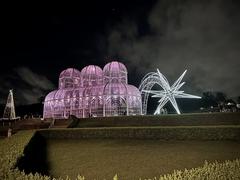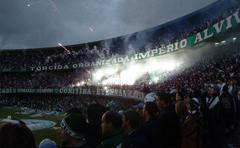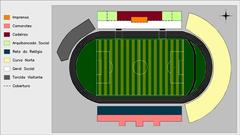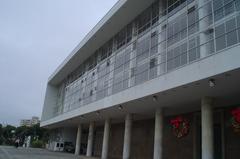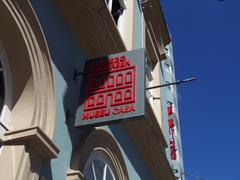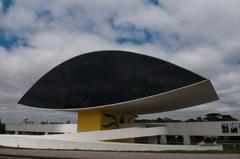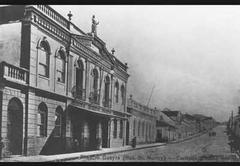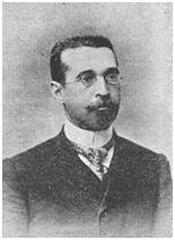Reservatório do Alto São Francisco: Visiting Hours, Tickets, and Historical Sites in Curitiba
Date: 03/07/2025
Introduction
The Reservatório do Alto São Francisco is a landmark of Curitiba, Brazil, renowned as the city’s oldest operational water reservoir and a symbol of early 20th-century innovation. This historical monument reflects not only significant engineering achievements but also Curitiba’s transformation into a modern metropolis. In this guide, you’ll find comprehensive information on its history, architectural significance, visiting hours, ticketing, guided tours, accessibility, and practical tips for exploring this and other nearby Curitiba historical sites.
Table of Contents
- Introduction
- Early Development and Urban Context
- Architectural Features and Engineering Innovations
- Role in Curitiba’s Water Supply System
- Visiting Information
- Historical Significance and Preservation
- Conservation Challenges
- Legacy and Community Engagement
- Visuals and Media
- Frequently Asked Questions (FAQ)
- Summary and Visit Tips
- References and Further Reading
Early Development and Urban Context
Constructed between 1904 and 1908, the Reservatório do Alto São Francisco was a foundational part of Curitiba’s modernization efforts, targeting the city’s urgent need for reliable potable water during a time of rapid population growth. Its elevated position was selected to enable gravity-fed water distribution, significantly reducing dependence on mechanical pumping—a forward-thinking engineering decision for the era (arquivoarquitetura.com; Fotografando Curitiba).
Connected by a 38-kilometer pipeline to the Serra do Mar springs, the reservoir replaced the city’s sole public fountain at Praça Zacarias. Upon its inauguration in 1908, it facilitated water access for nearly all of Curitiba’s 45,000 inhabitants, catalyzing public health improvements and supporting urban expansion (jera.site).
Architectural Features and Engineering Innovations
The reservoir’s architecture is a blend of utilitarian engineering and eclectic design. The above-ground structures—including the maneuvering house and the striking octagonal Art Nouveau fountain—feature robust brick masonry, stone foundations, full-arch openings, and sculptural ornamentation such as high-relief dolphins (curitiba-parana.net; Gazeta do Povo).
Beneath the surface, the reservoir comprises two vast chambers with vaulted ceilings supported by rows of pillars, reminiscent of ancient Roman cisterns. These chambers collectively hold around 6,881 cubic meters (approximately 6 million liters) of water, ensuring a steady supply to the city (guiadasemana.com.br).
The strategic use of gravity for water distribution was a major engineering advancement for its time. The design also incorporated ventilation through wrought-iron grilles and robust masonry for durability and temperature stability (Fotografando Curitiba).
Role in Curitiba’s Water Supply System
Upon completion, the Alto São Francisco Reservoir became a linchpin in Curitiba’s water supply network, distributing water to public taps and institutional buildings and significantly enhancing public health. The system’s success played a pivotal role in enabling the city’s subsequent growth and modernization (jera.site).
Visiting Information
Visiting Hours and Tickets
- Gardens & Exterior: Open daily from 8:00 AM to 6:00 PM. Free of charge.
- Subterranean Chambers: Not regularly open. Access is by special guided tour only, which must be scheduled in advance with Sanepar, Curitiba’s water utility (guiadasemana.com.br).
Accessibility and Location
- Address: Intersection of Rua Jaime Reis and Rua dos Presbíteros, São Francisco neighborhood, Curitiba.
- Access: Easily reached on foot from the city center (15-minute walk) or by public transportation.
- Accessibility: Gardens and exterior are wheelchair accessible; underground chambers are not due to stairs and narrow passages.
Guided Tours and Special Events
Special guided tours of the interior are occasionally organized and must be reserved in advance. These tours provide in-depth historical and technical insights and are led by experts in local history or engineering. Keep informed via the Curitiba tourism website and heritage blogs such as Circulando por Curitiba. The site also occasionally hosts cultural events, exhibitions, or educational programs.
Nearby Attractions and Travel Tips
The reservoir sits in the heart of the São Francisco district, making it an ideal starting point for exploring:
- Largo da Ordem: Known for its vibrant Sunday street fair.
- Museu Paranaense: Historic museum highlighting regional culture.
- Igreja da Ordem: The city’s oldest church.
- Rua São Francisco: Lined with cafes, bars, and historic architecture.
Public transit and limited street parking are available. Wear comfortable shoes for cobblestone streets; bring a jacket for cool interiors during tours. For a quieter experience, visit on weekday mornings.
Historical Significance and Preservation
The Reservatório do Alto São Francisco is officially protected as a heritage site by the State of Paraná since 1990 (patrimoniocultural.pr.gov.br). Ongoing conservation efforts focus on restoring ironwork, maintaining masonry, and ensuring the site’s continued function as part of Curitiba’s water supply. Preservation projects rely on collaboration among public agencies, local communities, and private sponsors (Fotografando Curitiba).
Conservation Challenges
Environmental exposure, urban encroachment, and structural aging pose ongoing challenges. Restoration uses traditional materials and techniques to preserve authenticity, and inclusion in heritage registers ensures legal protection against unauthorized alterations (Fotografando Curitiba).
Legacy and Community Engagement
The reservoir represents Curitiba’s early commitment to modernization, public health, and sustainable urban growth. Community engagement initiatives—such as educational programs, art projects, and guided tours—foster local pride and awareness of the city’s heritage (Gazeta do Povo). Responsible tourism is encouraged to protect the site’s integrity for future generations.
Visuals and Media
High-quality images of the reservoir’s gardens, iron grilles, and interior vaults are available through local tourism websites and blogs (Fotografando Curitiba). Alt tags such as “Exterior view of Reservatório do Alto São Francisco in Curitiba” and “Vaulted brick ceiling inside Reservatório do Alto São Francisco during a guided tour” are recommended for accessibility.
Alt tag: Exterior view of Reservatório Do Alto São Francisco showing brick façade and arched windows in Curitiba.
Frequently Asked Questions (FAQ)
Q: What are the visiting hours for the reservoir?
A: Gardens and exterior areas: daily, 8:00 AM to 6:00 PM. Interior access by appointment only.
Q: Is there an entrance fee or do I need a ticket?
A: No fee for exterior areas. Guided tours of the interior are free but require advance booking due to limited availability.
Q: How do I arrange a guided tour?
A: Contact Sanepar or check the Curitiba tourism website and Circulando por Curitiba for tour announcements.
Q: Is the site accessible for people with disabilities?
A: The outside is wheelchair accessible; interior chambers are not.
Q: Can I take photos inside?
A: Exterior photography is encouraged. For interior access, follow guide instructions.
Summary and Visit Tips for Reservatório do Alto São Francisco
The Reservatório do Alto São Francisco remains a vital emblem of Curitiba’s historical journey from a provincial town to a vibrant modern city. Its early 20th-century engineering ingenuity, architectural elegance, and enduring operational role underscore the reservoir’s importance as both technical infrastructure and a cultural treasure (arquivoarquitetura.com; Fotografando Curitiba). Ongoing preservation and community initiatives ensure its continued relevance and accessibility for future generations.
For the best experience, plan ahead by booking guided tours and monitoring official channels for event updates. Combine your visit with a walking tour of the São Francisco neighborhood and nearby Curitiba historical sites. Support responsible tourism to help safeguard this landmark’s heritage.
References and Further Reading
- This is a sample text. (arquivoarquitetura.com)
- This is a sample text. (Fotografando Curitiba)
- This is a sample text. (Galocha Cultural)
- This is a sample text. (Circulando por Curitiba)
- This is a sample text. (Curitiba Tourism)

